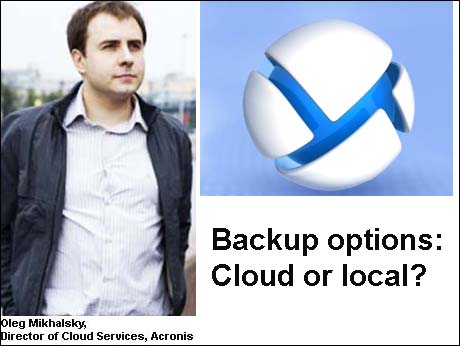
Oleg Mikhalsky, Director of Cloud Services at Acronis the data accessibility and protection solution providers, addresses a dilemma often faced by small and medium sized businesses: which is the better backup option? Will a hybrid work?
Many would agree that two copies are better than one. But redundancy has its cost, too. And then you have management overheads for two backup destinations and uncertainty of your recovery success rate with tape, disk or cloud. Sounds like a puzzle to solve. The key to efficient backup strategy with guaranteed outcome is to clearly define which goal you meet with each type of backup, and combine the two in the right way. Hybrid is not just about two copies, software vendors or service providers. It’s about making a smart – and budget-friendly – decision about your entire backup and recovery plan.
SMBs are increasingly adopting cloud solutions as part of their backup strategies – especially with volumes of data on the rise and economy conditions pushing to cut costs. Online backup will be one of the top-three service demanded by SMBs in 2013, according to Parallels SMB Cloud Insights report.
Sounds controversial, taking into account frequent concerns about security and reliability of cloud voiced by the majority of early adopters. So what is the reason that businesses decide to trust their backups - and ultimately their precious data - to the cloud, despite not being confident of the technology’s ability to be fit for purpose? An easy answer is that cloud backup is still better than not having a backup at all - and that is what should soon bring to cloud another 25 percent of SMBs who do not have any disaster recovery plan. That explains why many startups and pure-play cloud backup vendors are flooding the market with a simple “me-too” cloud backup, anticipating to cash-in on the growing demand. At a glance, they give the SMBs what they want, but is it what a responsible IT manager or business owner would need in order to stay protected and avoid going out of business in the event of a data loss?
A forward-looking person would think twice before being tempted by a quick fix and seemingly cheap solution. Start-ups come and go, and so may your data. And for those who survive, the question is: Can they can enhance their technology enough to meet the complete backup and disaster recovery needs that your growing business must have? Most online backup vendors only offer basic file-level backup, which is just as good as using a free Dropbox account to keep your files in the cloud. Would your investment of time and money in their offering eventually pay off? On the other hand – local backup typically means upfront cost of software and hardware that you may or may not be able to accommodate. But local backup vendors started earlier in the market and have developed more mature technologies, especially when it comes to system-level backup and application recovery.
How do you avoid a disaster without overspending? These questions can navigate you thought the decision-making process towards an efficient and reliable backup strategy. Ask yourself:
• Is there any data or system that in the case of downtime, needs to be recovered in minutes or hours?
• Is there any data or system that if corrupted or lost entirely, would affect your business continuity?
• Is there data that needs to be archived over a long period of time or accessed remotely?
In addition, you might come up with a few questions of your own aimed at better classifying your systems and data into three categories:
1. Needs fast recovery
2. Needs bullet-proof protection
3. Needs long-term storage
Now, each category can have its backup policy aligned with the main requirement you have identified: needs local backup, both local and cloud, or cloud only. Further, in case your available budget requires you to accept certain trade-offs, be prepared to go a level deeper and segment the data within a single category into tiers that can have different levels of protection, so you can optimize amount of local or cloud storage needed to fulfill a certain requirement.
Once you are done, the final question to ask is: What backup vendors offer a combination of features and technologies in a single offering that are mature and reliable and work equally well for both local and cloud destinations, giving you enough flexibility? At this point you would probably notice that even an established online backup vendor might not have a full set of local backup capabilities that the veterans of the backup world would offer you – especially when it comes to ultimate protection in the form of system-image backups – an essential technology for true cloud-based disaster recovery. The choice of vendors could become quite limited.
Using different software for on-site and cloud backups is leading to management overheads and is not cost-effective. With just one software solution to maintain and configure, you will have the ability to back up to both on-site and cloud destinations at the same time. Further, experienced users can configure retention rules and create sophisticated backup strategies. This means that you do not have to pay twice for the software, and there is no unnecessary investment of time, money or labor to train for different products.
The bottom line: Ask yourself a few simple questions to align the hybrid backup approach to your backup goals. As a result of dual local and cloud backup strategy, you get an unprecedented level of security and accessibility for your systems, applications and data. And using a single software solution capable of doing both reduces your cost and frees you from unnecessary management overheads. Acronis has this software for you. www.acronis.com
July 4 2013